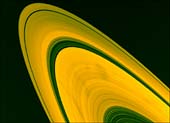
|
Table of Contents |
|
Saturn's Magnificent Rings
|
|
Saturn Science |
|
Other Resources |
In 1655 Christann Huyges proposed that Saturn was surrounded by a solid ring, "a thin, flat ring, nowhere touching, and inclined to the ecliptic." As time went on, more and more observations were made and theories proposed. It took until the mid 1800s before the notion that the ring was made out of small particles rather than being solid became the prominent theory.
In 1979 Pioneer 11 became the first spacecraft to fly past Saturn and take pictures of the planet and rings. Although the pictures are of low resolution by today's standards, they were better than any previous photos taken through telescopes. In 1980 and 1981 Voyager 1 and Voyager 2 flew past the planet and took numerous high-resolution images of Saturn and its rings. The next major milestone will be in 2004 when the Cassini spacecraft arrives at Saturn. Cassini will be the first spacecraft to go into orbit about the planet. Here it will operate studying Saturn, its moons, rings and environment for the next four years.
Ring Structure
Saturn's ring system is divided up into 7 major divisions with alphabetic designators in the order of discovery. From the innermost ring to the outermost ring the designators are D, C, B, A, F, G and E. Each major division is further subdivided into thousands of individual ringlets. The F and G rings are very thin and difficult to see while the A, B, and C rings are broad and quite visible. Between the A and B rings is a gap called the Cassini division named after Giovanni Cassini who discovered the Gap in 1676. Between the A and F rings lies the Keeler (Encke) gap.
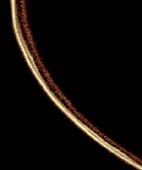
|
| Saturn's braided F-Ring. [more] |
In the mid 1980s Dr. Jeff Cuzzi noticed a wavy pattern in the ring material on both sides of the Encke gap. It was suggested that an unseen asteroid-sized moon in the gap caused the disturbance. Dr. Mark Showalter further analyzed the disturbance and used this "moonlet wake" pattern that resembled a motorboat wake, to determine the position and mass of the unseen body. The amplitude of the waves, he said suggested the mass of the unobserved object and the wavelength of the ripples revealed the moon's possible position. Using this mathematical model, Dr. Showalter was able to predict which Voyager images the moon would be in. In 1990 Dr. Showalter's work paid off and Pan was discovered within the Encke gap.
| Name | Distance* (km) | Width (km) | Thickness (km) | Optical Depth | Mass (g) | Albedo |
|---|---|---|---|---|---|---|
| D | 66,000 - 73,150 | 7,150 | ? | 0.01 | ? | ? |
| C | 74,500 - 92,000 | 17,500 | ? | 0.05 - 0.35 | 1.1 x 1024 | 0.12 - 0.30 |
Maxwell Gap | 87,500 | 270 | ||||
| B | 92,000 - 117,500 | 25,500 | 0.1 - 1 | 0.8 - 2.5 | 2.8 x 1025 | 0.5 - 0.6 |
Cassini Div | 117,500 - 122,200 | 4,700 | ? | 0.05-0.15 | 5.7 x 1023 | 0.2 - 0.4 |
| A | 122,200 - 136,800 | 14,600 | 0.1 - 1 | 0.4-0.5 | 6.2 x 1024 | 0.4 - 0.6 |
Encke gap | 133,570 | 325 | ||||
Keeler gap | 136,530 | 35 | ||||
| F | 140,210 | 30 - 500 | ? | 0.01-1 | ? | 0.6 |
| G | 164,000 - 172,000 | 8,000 | 100 - 1000 | 10-6 | 1020 | ? |
| E | 180,000 - 480,000 | 300,000 | 1,000 | 10-5 | ? | ? |
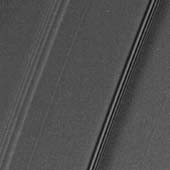
|
| Resonance Waves. [more] |
Resonance Structures - Gaps and Spiral Waves
Many of Saturn's ring structures appear to be the results of resonance with outer satellites. Several of the gaps or gap edges are located at positions of resonance. The outer edge of the A-ring seems to be shaped like a six lobed petal and is at a 7:6 resonance with Janus. At this resonance, ring materials circle Saturn 7 times while Janus orbits 6 times. The boundry between the outer edge of the B-ring and the Cassini divison is at a 2:1 resonance with Mimas. The Encke gap is at a 5:3 resonance with Mimas.In addition to the gaps, resonance manifests itself in other ways. One prominent structure within the A-Ring is a 5:3 resonance with Saturn's moon Mimas. This Voyager 2, close encounter image of Saturn's A-Ring, shows two wave patterns formed from the Mimas resonance perturbations. On the left is an outward propagating spiral density wave formed by particles that are bunched together in a spiral pattern. On the right is an inward propagating spiral bending wave that is made up of vertical oscillations of the ring material. The distance between these two waves is about 400 kilometers.
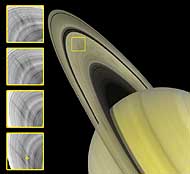
|
| Formation of Ring Spokes. [more] |
Ring Spokes
One of the curious discoveries made by the Voyager spacecraft was the presence of dark radial features up to 20,000 kilometers long that move in curious patterns on the B ring. These features commonly known as spokes had scientists perplexed because they seemed to defy gravity. Spokes are thought to be microscopic dust particles that have levitated away from the ring plane. They appear on both sides, near the densest part of the B ring. They rotate at the same rate as Saturn's magnetic field indicating they are affected by electromagnetic forces. They form about 104,000 kilometers from Saturn's center and extend out to the Cassini division. They are shapped somewhat like an hour glass with the narrow centers located near the synchronous orbit radius. Perhaps they are formed by meteorites that punch through the rings, by tiny moonlets as they plunge through the rings, or dust particles that have taken on a charge and levitated off the larger ring bodies.Ring Formation and Composition
Saturn's rings span a great distance with the inner D ring approximately 6,700 kilometers from Saturn's cloud tops to the fringes of the E ring, 480,000 kilometers out. Surprisingly, most of the rings are only a few tens of meters thick with a total mass equivalent to a medium sized moon. The rings are made out of particles ranging from microscopic dust to barnyard sized boulders with perhaps a few kilometer-sized objects as well. Near-infrared observations from Earth have shown that the rings are composed mostly of ice crystals with some impurities.
Scientists once thought that the rings were formed at the same time, as the planets when they coalescing out of swirling clouds of interstellar gas 4.8 billion years ago. Under this model, remnants of material within the Roche limit could not condense and would become rings. However, in recent years this idea seems to be flawed. The rings appear to be young, perhaps only hundreds of millions of years old. One of the clues to this theory is that the rings are bright. As Saturn travels though space, the rings accumulate dust particles that have been darkened from solar radiation. If the rings were old, they should appear dark. Another theory suggests that perhaps a comet few too close to Saturn and tidal forces broke it into pieces similar to comet Shoemaker-Levy/9. Perhaps one of Saturn's moons was struck by an asteroid smashing it into the bits and pieces that form the rings. Hopefully the Cassini spacecraft can answer some of these questions.
Ring Photo Gallery
 In Saturn's Shadow
In Saturn's Shadow
With giant Saturn hanging in the blackness and sheltering Cassini from the sun's blinding glare, the spacecraft viewed the rings as never before, revealing previously unknown faint rings and even glimpsing its home world.
This marvelous panoramic view was created by combining a total of 165 images taken by the Cassini wide-angle camera over nearly three hours on Sept. 15, 2006. The full mosaic consists of three rows of nine wide-angle camera footprints; only a portion of the full mosaic is shown here. Color in the view was created by digitally compositing ultraviolet, infrared and clear filter images and was then adjusted to resemble natural color.
The mosaic images were acquired as the spacecraft drifted in the darkness of Saturn's shadow for about 12 hours, allowing a multitude of unique observations of the microscopic particles that compose Saturn's faint rings.
Ring structures containing these tiny particles brighten substantially at high phase angles: i.e., viewing angles where the sun is almost directly behind the objects being imaged.
During this period of observation Cassini detected two new faint rings: one coincident with the shared orbit of the moons Janus and Epimetheus, and another coincident with Pallene's orbit.
The narrowly confined G ring is easily seen here, outside the bright main rings. Encircling the entire system is the much more extended E ring. The icy plumes of Enceladus, whose eruptions supply the E ring particles, betray the moon's position in the E ring's left-side edge.
Interior to the G ring and above the brighter main rings is the pale dot of Earth. Cassini views its point of origin from over a billion kilometers (and close to a billion miles) away in the icy depths of the outer solar system.
Small grains are pushed about by sunlight and electromagnetic forces.
Hence, their distribution tells much about the local space environment.
(Courtesy NASA/JPL/Space Science Institute)
 Panoramic Rings
Panoramic Rings
Saturn's most prominent feature, its dazzling ring system, takes center
stage in this stunning natural color mosaic which reveals the color and
diversity present in this wonder of the solar system. Gaps, gravitational
resonances and wave patterns are all present, and the delicate color
variations across the system are clearly visible.
This mosaic of six images covers a distance of approximately 62,000 kilometers along the ring plane, from a radius of 74,565 kilometers to 136,780 kilometers (46,333 to 84,991 miles) from the planet's center.
This view is from Cassini's vantage point beneath the ring plane. The
rings are tilted away from Cassini at an angle of about 4 degrees.
(Courtesy NASA/JPL/Space Science Institute)
![]() Cat's Eye Rings and Peek-a-boo Shadows
Cat's Eye Rings and Peek-a-boo Shadows
Astronomers have long known that Saturn's rings reflect sunlight most
strongly when Earth is located directly between Saturn and the sun. Flat,
shiny surfaces (like a mirror or a pond) can appear particularly bright
when light reflects off them in a certain direction. Scientists call this
"specular reflection," from the Latin word for mirror. However, even rough
surfaces, like those of Earth's moon or Saturn's rings, can appear bright
when the source of light is directly behind the observer's head, no matter
what the orientation of the surface is. This latter phenomenon is known as
the "opposition effect." Spectacular examples include the eyes of a cat,
which seem to glow brightly when they are illuminated by a flashlight, or
highway signs and reflectors that "light up" when they are caught in a
car's headlights.
On Aug. 16, 2006, as the Cassini orbiter flew directly between the sun and Saturn, its Visual and Infrared Mapping Spectrometer captured a sequence of images that vividly show this opposition brightening. Combined here into a mosaic, the images show -- from left to right -- a small, bright spot moving from the outermost B ring across the Cassini Division and all the way across the A ring. In each image, this spot is centered on the point in the rings directly opposite the sun. Theoretical models for the opposition effect suggest that it can be explained by light being scattered several times within the surfaces of individual, transparent, icy ring particles on scales of about 40 micrometers, or 1/500th of an inch. Similar effects are seen in laboratory studies of bright, finely-textured material such as snow or sugar crystals.
In this mosaic, blue colors highlight the icy rings (2.35 microns), green represents sunlight reflected by the clouds of Saturn (2.86 microns) and red depicts thermal emission from the planet's interior (5.02 microns). The rings were observed while they were in front of the planet, producing a complex interplay of sunlight reflected from the rings and the shadows cast by the rings on the cloud tops of Saturn. The yellow-green sunlit clouds of Saturn are seen in the upper right corner of the mosaic beyond the outer edge of the A ring, and also through the 4,000-kilometer-wide (2,400 mile) Cassini Division in the left third of the mosaic. (Yellow indicates a mixture of reflected sunlight and thermal emission.) The shadowed regions of the planet, on the other hand, appear deep red because only thermal emission produced deep inside Saturn itself is visible.
At exact opposition, the shadows of the rings are hidden behind the rings
themselves, but away from this point shadows can be seen peeking out from
behind the edges of the A and B rings into the Cassini Division, as well
as beyond the outer edge of the A ring. If one looks closely, one can even
trace the A ring's shadow behind the partly transparent A ring, as a faint
purple band. Within this band, a thin blue-green line crossing obliquely
behind the A ring is caused by sunlight passing through the narrow Encke
Gap in the outer A ring.
(Courtesy NASA/JPL/University of Arizona)
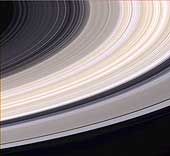 Ringscape In Color
Ringscape In Color
Nine days before it entered orbit, Cassini spacecraft captured this exquisite natural color view of Saturn's rings. The images that make up this composition were obtained from Cassini's vantage point beneath the ring plane with the narrow angle camera on June 21, 2004, at a distance of 6.4 million kilometers (4 million miles) from Saturn. The image scale is 38 kilometers (23 miles) per pixel.
The brightest part of the rings, curving from the upper right to the lower left in the image, is the B ring. Many bands throughout the B ring have a pronounced sandy color. Other color variations across the rings can be seen. Color variations in Saturn's rings have previously been seen in Voyager and Hubble Space Telescope images. Cassini's images show that color variations in the rings are more pronounced in this viewing geometry than they are when seen from Earth.
Saturn's rings are made primarily of water ice. Since pure water ice is
white, it is believed that different colors in the rings reflect different
amounts of contamination by other materials such as rock or carbon
compounds. In conjunction with information from other Cassini instruments,
Cassini images will help scientists determine the composition of different
parts of Saturn's ring system.
(Courtesy NASA/JPL/Space Science Institute)
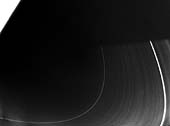 Saturn's Faint Inner D-Ring
Saturn's Faint Inner D-Ring
The D-ring of Saturn is very tenuous and has an extremely small optical depth.
This picture was taken 1 hour and 48 minutes before Voyager 2's closest approach
to Saturn on August 25, ???? from a distance of 195,400 kilometers. At this
resolution, many ringlets and gaps are present in the image.
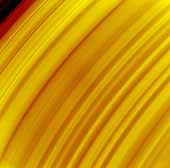 Ringlets of Saturn's B-Ring
Ringlets of Saturn's B-Ring
This pseudo-colored image of the outer edge of Saturn's B-ring shows
the ring structure broked up into numerous ringlets. The narrowest features
are about 15 kilometers wide with the overall image about 6,000
kilometers wide. Variations in brightness are due to a combination
of differences in ring particle number density and light scattering
properties. The B-ring is the most opaque of Saturn's rings.
The Cassini division is located at the upper left.
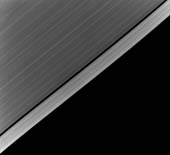 Close Encounter with Saturn's A-Ring
Close Encounter with Saturn's A-Ring
This high-resolution image shows the outer edge of Saturn's A ring. The many sharp
linear features parallel to the ring edge are most probably locations where ring
particles are in resonance with one of the several small nearby satellites. Such
regions with nearby satellites are likely characterized by more intense particle
collisions and a greater density of small "chips." The entire outer band of the
A-ring has different scattering properties and therefore different particle
characteristics than the main body of the rings to the upper left. The resolution
of this image is about 4 kilometers (2.5 miles).
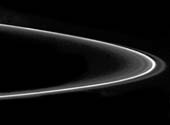 Saturn's F-Ring
Saturn's F-Ring
Voyager 2 obtained this picture of Saturn's F-ring on
August 26, 1981 just before the spacecraft crossed the
planet's ring plane. This edge-on view, taken from a
range of 103,000 kilometers (64,000 miles), shows
nearly 25` of the F-ring, with at least four distinct
components visible.
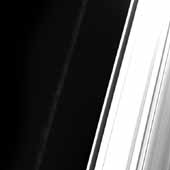 Saturn's G-Ring
Saturn's G-Ring
Saturn's G ring was discovered by Voyager 1 in November 1980 and imaged
again by Voyger 2 on August 26, 1981 from a range of about 175,000 kilometers.
The 8000 kilometer wide G-ring is extreamly tenuous and difficult to see.
It is more neutral in color than the E-ring. In this image the A-ring on
the right hand side has been washed out due to the long exposure required
to bring out the G-ring. Significant image processing was used to
isolate the G-ring from the background noise.
This included carefully flattening the image intensity across the image plane
with low and high pass filtering applied to the G-ring region.
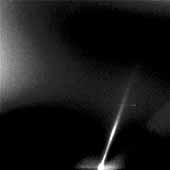 The Marvelous E-ring
The Marvelous E-ring
Saturn's tenuous outer E-ring lies from about 180,000 kilometers to 640,000
kilometers from the planet. The ring's brightness peaks near the orbit of
Saturn's moon Enceladus with vertical thickness smallest at
this orbit. This indicates that Enceladus may be the source of the
ring. Voyager spacecraft photographs show that Enceladus appears to be
curiously smooth almost as if it has been recently resurfaced by watery
volcanoes or geyser. Erupting geysers may be responsible for ejecting
material into the E-ring.
Another predominant theory suggests that the ring material may be ejecta that was blasted off of Enceladus' surface by bombarded with particles traveling at extremely high velocities. As these particles strike the surface they are destroyed in micro-explosions that ejects new particles into space. Over time these particles may be destroyed by self-collisions or by colliding once again with the parent satellite.
One of the unusual characteristics of the E-ring is that it is predominately composed of micron sized grains with a distinct blue color. When particles are ejected into space they are subject to the gravitational forces that control the orbits of the moons and planets; however, small particles are greatly affected by other forces such as light pressure from the Sun, and electromagnetic fields around Saturn. Micron sized particles seem to be privileged. The gravitational and size-dependent non-gravitational forces balance for micron size particles. Only micron-sized particles can survive for long periods of time and spread out over the large expanse of the E-ring.
Also visible in this image, between the E Ring and the overexposed outermost part of the main rings near the lower edge of the frame, is the tenuous, thin, 8000 km-wide G Ring. Noticeably thinner than the E Ring and more neutral in color, the G Ring is thought to be composed of larger, macroscopic particles.